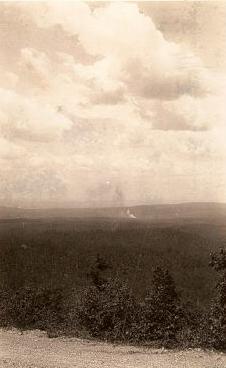"No Man's Land Fire" .. its remote location seven miles west of Black Springs in Montgomery County.A wildfire has spread through a section of the Ouachita National Forest in western Arkansas. Officials said today the fire had spread over more than eight-thousand acres. Note the spelling mistake in the photo caption - Mina should read Mena.Montgomery County News, Thursday March 23 2006, page 1 It took five days, local fire crews and out of state fire crews, an inter-tribal crew composed 20 Iowa and Cherokee Native Americans from Oklahoma and 20 Northwest Regulars from Washington State, a Type 2, Initial Attack group, and three days of rain to finally stop the spreading "No Man's Land Fire" in southwest Montgomery County, Arkansas. 8,123 acres was burned. Four fires were first reported to the local ranger stations on Monday, March 13 after a storm Sunday night. Three were quickly put out. The one fire that started on Bear Den Mountain about seven miles west of Black Springs on Highway 8 and one and a half miles south of the pavement from a lightening strike grew for a few days and then exploded from the initial 700 acres. The fire spread south onto Statehouse Mountain. The crews lined up along Roads 43 and 73 and started back fires. The back burn fires burned up the undergrowth and denied the main fire the fuel necessary to continue spreading. The fire was also stopped to the east by a defensive position along Polk Creek. Over flights were later done to determine if there were any hot spots and the extent of the damage done.
SOUTHERN FIRES KEEP CREWS AND AIRCRAFT BUSYSO # P-Code Date District IQCS and Incident Numbers Fire Name 41 P8CD5X 3/13/2006 CAD/WOM IQCS ID 00000059293 AR-OUF-006291 NO MANS LAND MARCH 16 -- TULSA, OK: The Southern Area Coordination Center (SACC) reported that initial attack yesterday included over 200 fires in Florida, Mississippi, North Carolina, Oklahoma, Tennessee, and Virginia. The No Man's Land Fire in Arkansas was at 300 acres this morning with zero containment, and reported tonight at 2,000 acres with 20 percent containment. The fire started on Monday in Montgomery County west of Little Rock and had air tankers on it today after proving a challenge yesterday; it's burning in heavy fuels with thick underbrush, and yesterday burned through retardant lines and jumped fire lines. The fire's in steep rocky terrain in a remote area with difficult access. The fire's burning in hardwood litter and deadfall from the ice storm that hit the area hard almost six years ago, with six or eight feet of brush growing up since then through the deadfall of the 2000 storm. More than 50 personnel are assigned to the fire. Hot Springs, AR - A large wildfire on the Ouachita National Forest in
Montgomery County continues to burn. The fire, named "No Mans Land
Fire", is located on the Caddo/Womble Ranger District, 7 miles west of
Black Springs and south of Highway 8. The fire was 65% contained as of
Saturday morning. It is expected to be 100% contained by nightfall.
Lightning is believed to have caused the fire, which has already burned
approximately 8,000 acres.
Current resources working this fire include helicopters from the Mena
Helibase, tankers and lead planes from Ardmore, Oklahoma, dozers,
engines, and 75 personnel including two firefighting crews along with
local resources. A forest fire that had been growing slowly all week exploded into a
remote and rugged part of the Ouachita National Forest on Friday,
consuming thousands of acres, a U. S. Forest Service official said.
The fire, triggered by lightning Sunday, had burned 800 acres by
Thursday and Forest Service officials had expected it to grow, U. S.
Forest Service spokesman Debbie Ugbade said. And grow it did. By early Friday evening the fire, named No Man’s Land
for its remote locale, had ravaged 5, 000 to 7, 000 acres, Ugbade said.
“Our priority is still protecting people and property,” she said.
Fire crews took steps to protect 10 homes and a church, she said, but no
evacuations were ordered.
“It is the largest fire on the Caddo Ranger District in history and
possibly on the forest since 1960 s,” Ugbade said of the fire seven
miles west of Black Springs in Montgomery County.
The blaze was expected to grow to 10, 000 acres before crews could
contain it. By late Friday the fire was 35 percent contained.
Ugbade said the fire should be contained this afternoon with some help
from Mother Nature. “I hope we have rain,” she said.
In the meantime, fire crews from Oklahoma and Washington along with 15
to 20 employees from the Natural State were using backburns and relying
on rural roads for break lines, Ugbade said.
Helicopters from the Mena Helibase dropped water, and large Forest
Service tankers capable of dropping 2, 500 gallons of retardant, made
drops as well. Ugbade was not sure how many drops were made Friday but
said the tankers made four drops Thursday.
“We’re mostly fighting it from the air because of the rough terrain,”
she said. “We can’t actually get in there to fight the fire.” |
